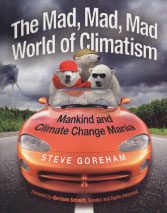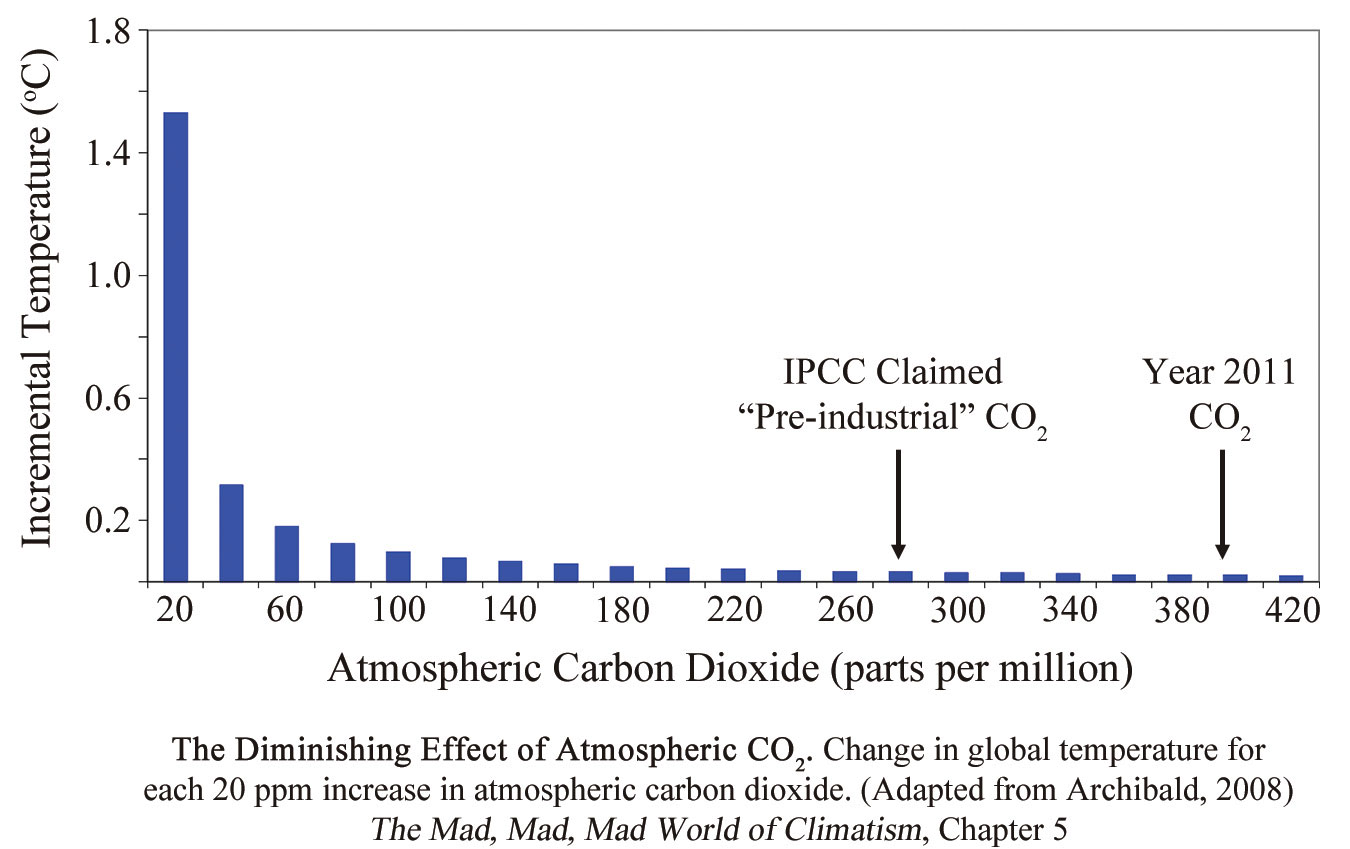
The Mad, Mad, Mad World of Climatism: Mankind and Climate Change Mania, by Steve Goreham, New Lenox, Illinois: New Lenox Books, 2012, 301 pages, softcover.
With today’s media drumbeat of impending catastrophes triggered by man’s destructive effects on our climate, Steve Goreham’s latest book certainly does add cognitive dissonance to the public square. This book forthrightly exposes the lack of scientific evidence for what Goreham calls the ideology of “Climatism” — the hypothesis of dangerous man-made climate change — with which Climatists try to justify all of their urgently promoted, but demonstrably misguided, policy initiatives.
After illustrating the worldwide extent of Climatism in the first two chapters of The Mad, Mad, Mad World of Climatism, Goreham soundly demonstrates that there is no scientific evidence supporting the hypothesis of dangerous man-made climate change. And therefore, climate change is not the existential threat to life on Earth, as fanatical proponents of Climatism want you to believe. But that’s not all — in subsequent chapters, Goreham shows that the entire, fantastic structure of alleged consequences of man-made climate change is as flimsy as a house of cards, and that many opportunists promoting climate legislation have been profiting quite handsomely from the ideology of Climatism. With his straightforward and often humorous compilation of vital evidence exposing the flaws in Climatist arguments, Goreham, a scientist with an M.S. in Electrical Engineering, methodically dismantles Climatism, along with all the madness that Climatism has spawned.
Let’s start our analysis where Goreham examines the faulty hypothesis of Climatism: the idea that man-made CO2 dangerously influences the climate. It is true that water vapor, CO2, methane, and other trace gases are known to exert a “greenhouse” warming effect upon the Earth. However, as CO2 increases, its greenhouse effect diminishes logarithmically, so that increasing levels of CO2 have a diminishing warming effect. He uses analogy to make his point:
Just as adding more blankets to the first blanket on your bed provides a diminishing warming benefit, adding more CO2 to the atmosphere has a declining warming effect. Doubling of atmospheric CO2 from 280 parts per million to 560 parts per million, whether from natural or man-made causes, would by itself increase Earth’s surface temperature by only 1.2°C.
 It is also true that the atmospheric concentration of CO2 has risen over the last 50 years, from 315 parts per million in 1958 to 392 parts per million today — about a 24 percent increase, with only a minimal warming effect.
It is also true that the atmospheric concentration of CO2 has risen over the last 50 years, from 315 parts per million in 1958 to 392 parts per million today — about a 24 percent increase, with only a minimal warming effect.
But what is causing that increase? Man currently releases into the atmosphere about 22 billion tons of CO2 per year. That may seem like a large amount — but in what context? Natural forces all around us — decaying plants and trees, volcanoes, ocean out-gassing of CO2, etc. — release into the atmosphere an estimated 781 billion tons of CO2 per year, which is roughly counterbalanced by an estimated re-absorption of 788 billion tons of CO2 per year into living plants and into the oceans. Man’s CO2 output per year is less than three percent of the totals released by the combination of all natural forces and man — about 803 billion tons.
Furthermore, it is worth noting for context that the oceans are a huge reservoir of 139 trillion tons of CO2. According to Goreham, “50 times more CO2 is dissolved in Earth’s oceans than is found in the atmosphere.” (Emphasis in original.) Man’s yearly output of CO2 is only 0.016 percent of the oceans’ total reservoir — a proverbial “drop in the bucket.” And when natural forces warm oceans, the oceans then release CO2, which could explain the recent rise in concentrations of CO2.
According to Goreham, “about 75 percent of the greenhouse effect is due to water vapor and clouds, and of the remaining portion, about 19 percent is due to carbon dioxide, with 6 percent due to methane and other gases.” And since “only about three percent of the CO2 placed into the atmosphere each year is from human emissions,” therefore, at most, “mankind is responsible for only about one percent of the greenhouse effect!” (Emphasis in original.)
“In conclusion,” writes Goreham, “man’s contribution to the greenhouse effect is about one percent of the total, but when we also consider evaporation, convection, and the forces of weather, human influences are an even smaller share than one percent of the total heating or cooling of Earth’s surface. This means that if we halted all man-made emissions, we might not even be able to measure the change in Earth’s temperatures.” (Emphasis in original.) Thus, ordinary weather obscures man’s negligible contribution to the greenhouse effect — against a background of gargantuan natural forces on the Earth and in the oceans that are constantly releasing and re-absorbing vast quantities of CO2 that are several orders of magnitude larger than man’s comparatively tiny output of CO2.
So, do Climatists acknowledge that man’s proportionally minuscule production of CO2 couldn’t possibly change the climate? Oh, no-o-o! Instead, they try to save the hypothesis of man-made climate change with a secondary hypothesis that warming caused by CO2 could increase concentrations of water vapor, which in turn could add to the initial warming effect of CO2. Thus, “Water vapor is expected to amplify the greenhouse warming effect of carbon dioxide.”
Is there any evidence to support this secondary hypothesis of warming from water vapor triggered by CO2? No. The rise in water vapor predicted by this hypothesis “does not appear.”
Then are Climatists willing to accept the lack of evidence for their secondary hypothesis? No way! Too much is at stake! Instead, they filibuster the scientific results that contradict their secondary hypothesis by repeatedly blaming and finding fault with the scientists who have shown that there is no evidence to support the amplifying role of water vapor on contextually minuscule quantities of man-made CO2.
In contrast to the demonstrably false assumptions of Climatism, Goreham presents plenty of scientific evidence that climate change is driven by natural forces, specifically by the interactions of solar cycles, cosmic rays, and cloud cover. For all practical purposes, we human beings have only a negligible influence on climate change — contrary to what Climatists would have you believe. In this context, it is worthwhile to point out that the histrionic alarmism characteristic of Climatism is simply incompatible with biblical appreciation of God’s superintending care for His Creation ( — e.g., Job, chapters 38-42).
But if there is no scientific evidence to support Climatism, why does it still persist? Goreham’s book is replete with mind-boggling examples of Climatists using the media, the law, and education to ensconce the idea of Climatism in majority opinion. As Alexis de Tocqueville observed in early America, once an idea is thought to be supported by the majority, the dynamics of what de Tocqueville calls “majority tyranny over thought” ensure that this idea will be very difficult to dislodge. He explains:
The more alike men are, the weaker each feels in the face of all. Finding nothing that raises him above their level and distinguishes him, he loses his self-confidence when he comes into collision with them. Not only does he mistrust his own strength, but even comes to doubt his own judgment, and he is brought very near to recognizing that he must be wrong when the majority hold the opposite view. There is no need for the majority to compel him; it convinces him.
For more than 25 years, Climatists have promoted the propaganda of man-made climate change in a shameless attempt to perpetuate Climatism and the madness built upon it, while discouraging most people from questioning it. Most people still lack the knowledge, as well as the inclination, to analyze and then reject the faulty hypothesis of dangerous man-made climate change.
Thankfully, Steve Goreham and other alert citizens have been confronting Climatism by igniting a very public intellectual fire to expose and thereby neutralize the falsehood of dangerous man-made climate change. According to Goreham, “This book will help you sort fact from fiction in the global warming debate. It will remove the fear and paranoia that you and your family may be feeling from daily bombardment of climate change nonsense from work, school, and community.”
Goreham does make two fairly common political mistakes. He mistakenly refers to our polity as a “democracy,” and he seems to be unaware of the unconstitutionality of his well-intended suggestion to reallocate taxpayer money from attempting to mitigate climate change, to helping the world’s poor. But in the context of the cornucopia of scientific insights into Climatism that Goreham provides, these political errors are minor blemishes.
In a recent personal interview, Goreham pointed out, “This is the first climate book that’s fun to read. It is aimed at regular citizens. It is meant to be interesting. Of course this book presents a comprehensive analysis of the science involved, but I also want to recommend Chapter 12 — ‘You Can’t Make This Stuff Up’ — which shows what some people will do under the influence of Climatism.”
This article is an example of the exclusive content that’s only available by subscribing to our print magazine. (To see a PDF of this article as it appeared in the print magazine, click here.) Twice a month get in-depth features covering the political gamut: education, candidate profiles, immigration, healthcare, foreign policy, guns, etc. Digital as well as print options are available!



